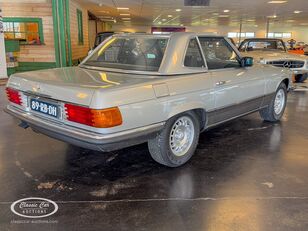Kupee Porsche 912 "BULZI"

















































Kui olete otsustanud osta madala hinnaga tehnikat, veenduge, et suhtlete tegeliku müüjaga. Uurige välja võimalikult palju infot tehnika omaniku kohta. Üks petmisviisidest on esineda tegelikult olemasoleva ettevõtte nime all. Kahtluste tekkimise korral teatage sellest meile tagasisidevormi kaudu, et saaksime asja täiendavalt kontrollida.
Enne ostu sooritamist uurige hoolikalt erinevaid müügipakkumisi, et selgitada välja teie poolt valitud tehnika mudeli keskmine hind. Kui teie valitud müügipakkumise hind on oluliselt madalam sarnaste pakkumiste hindadest, olge ettevaatlik. Suur hinnaerinevus võib viidata varjatud defektidele või müüja petmiskatsele.
Ärge ostke kaupa, mille hind erineb tunduvalt analoogse tehnika keskmisest hinnast.
Ärge nõustuge kahtlaste tagatis- ja ettemaksudega. Kahtluste korral ärge kartke täpsustada üksikasju, küsige müüdava tehnika lisafotosid ja dokumente, kontrollige dokumentide ehtsust, esitage lisaküsimusi.
See on kõige levinum petmise viis. Ebaausad müüjad võivad küsida teatud ettemaksusummat, et „broneerida“ teile tehnika ostmise õigus. Sel moel võivad petised koguda suure rahasumma ja seejärel kaduda, nii et nendega pole enam võimalik ühendust võtta.
- Ettemaksu kandmine kaardile
- Ärge makske ettemaksu, vormistamata dokumente, mis tõendavad raha üleandmise akti, kui teil tekib müüjaga suhtlemisel kahtlusi.
- Raha kandmine „vahendaja“ kontole
- Selline palve peab tegema ettevaatlikuks; tõenäoliselt suhtlete kelmiga.
- Raha kandmine sarnase nimega ettevõtte kontole
- Olge tähelepanelikud, kelmid võivad esineda tuntud ettevõtete nimel, tehes ettevõtte nimes väikeseid muudatusi. Ärge kandke raha üle, kui ettevõtte nimi tekitab kahtlusi.
- Oma pangarekvisiitide märkimine reaalse ettevõtte nimel esitatud arvele
- Enne ülekande tegemist kontrollige, kas arvele märgitud pangarekvisiidid on õiged ja kuuluvad vastavale ettevõttele.
Müüja kontaktid

 Holland
Holland 




























































= Weitere Informationen =
Allgemeiner Zustand: durchschnittlich
Technischer Zustand: durchschnittlich
Optischer Zustand: durchschnittlich
Mehrwertsteuer/Differenzbesteuerung: Mehrwertsteuer abzugsfähig
Teknisk stand: gennemsnitlig
Visuelt udseende: gennemsnitlig
moms/margin: Moms fradragsberettiget
Please contact andrew V D Berghe (kuva kontaktid, kuva kontaktid) for more information
= More information =
Technical condition: average
Visual appearance: average
VAT/margin: VAT qualifying
= More information =
Please contact Shane Zegwaard (kuva kontaktid, kuva kontaktid) for more information
= More information =
General condition: average
Technical condition: average
Visual appearance: average
VAT/margin: VAT qualifying
Estado técnico: medio
Estado óptico: medio
IVA/margen: IVA deducible
État technique: moyen
État optique: moyen
TVA/marge: TVA déductible
In 1963, Porsche assigned Dan Schwartz, later Chief Departmental Manager for Development, Mechanics, a project to oversee design and construction of a new horizontally-opposed four-cylinder engine for the 902, utilizing components from the new 901 six-cylinder engine, that would produce higher performance than their 356SC engine, and be less costly and complex than their Carrera 2 engine. Another option explored by Claus von Rücker was to increase displacement of the 356 Type 616 engine to 1.8-liters, add Kugelfischer fuel injection, and modify both valve and cooling systems. Considering performance, cost, and scheduling, Porsche discontinued both of these design projects, and instead developed a third option, to tailor the 1.6-liter Type 616 engine to the 902.[4][5]
Before 911 production commenced in 1964, the Porsche Vehicle Research Department had set aside chassis numbers 13328, 13329, 13330, 13352, and 13386 through 13397 for research testing of the 902; research vehicle Serial Number 13394 is the oldest 902 known to exist today. In production form, the Type 912 combined a 911 chassis / bodyshell with the 1.6L, four-cylinder, push-rod Type 616/36 engine, based upon the Type 616/16 engine used in the Type 356SC of 1964-1965. With a lower compression ratio and new Solex carburetors, the Type 616/36 engine produced five less horsepower than the 616/16, but delivered about the same maximum torque at 3,500 rpm versus 4,200 rpm for the 616/16. Compared to the 911, the resulting production Type 912 vehicle demonstrated superior weight distribution, handling, and range. To bring 912 pricing close to the 356, Porsche also removed some features standard on the 911. As production of the 356 concluded in 1965, on April 5, 1965 Porsche officially began production of the 912 coupé.[6] Styling, performance, quality construction, reliability, and price made the 912 a very attractive buy to both new and old customers, and it substantially outsold the 911 during the first few years of production. Porsche produced nearly 30,000 912 coupé units and about 2500 912 Targa body style units (Porsche''s patented variation of a cabriolet) during a five-year manufacturing run.
= Meer informatie =
Motorrijtuigenbelasting: geen
Neem voor meer informatie contact op met andrew V D Berghe (kuva kontaktid, kuva kontaktid)
= Meer informatie =
Technische staat: gemiddeld
Optische staat: gemiddeld
BTW/marge: BTW verrekenbaar voor ondernemers
= Meer informatie =
Motorrijtuigenbelasting: geen
Neem voor meer informatie contact op met Shane Zegwaard (kuva kontaktid, kuva kontaktid)
= Meer informatie =
Algemene staat: gemiddeld
Technische staat: gemiddeld
Optische staat: gemiddeld
BTW/marge: BTW verrekenbaar voor ondernemers
Stan techniczny: średnio
Stan wizualny: średnio
VAT/marża: Możliwość odliczenia podatku VAT
Estado técnico: média
Aspeto visual: média
IVA/margem: IVA elegível
Техническое состояние: среднее
Внешнее состояние: среднее
НДС/маржа: С вычетом НДС
Tekniskt tillstånd: genomsnitt
Optiskt tillstånd: genomsnitt
Moms/marginal: Avdragsgill moms för företagare